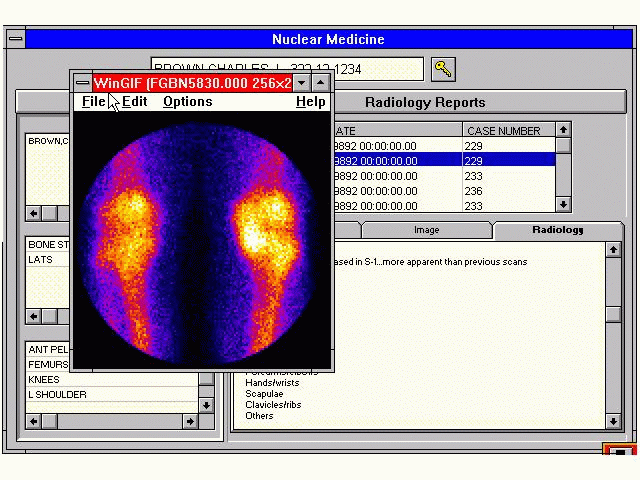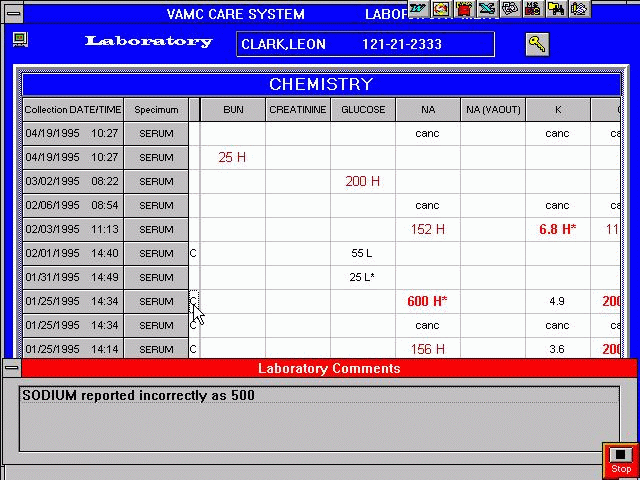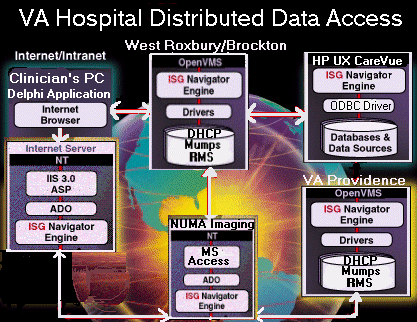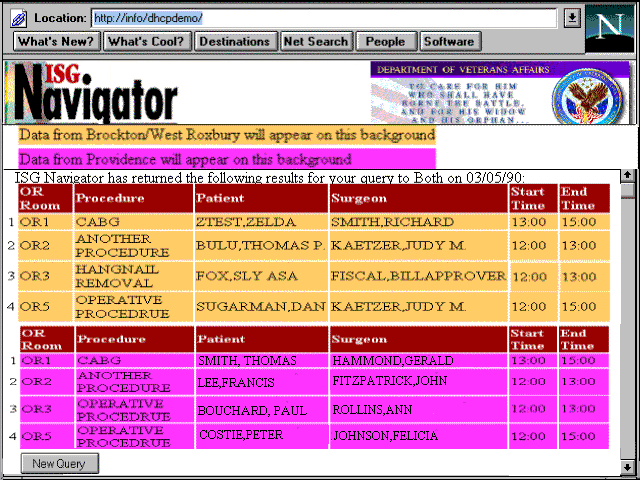![]()
![]()
VA Hospital and ISG
Clinical Medical Record
Standardized Data Access to DHCP Mumps Data for Client Server & Intranet Applications
The On-line Clinical Medical Record
The U.S. Veterans Administration at the Brockton/West Roxbury Medical Center in Massachusetts has developed a working model of an on-line clinical medical record system that retrieves patient case information and cumulative clinical data from disparate databases realtime. The PC accessible application has an intuitive and customizable interface. It enables clinicians to obtain personalized views of patient data that decrease the acquisition and processing time of retrieving clinical information. It was based entirely on industry standards and commercial software products to ensure lowest cost of ownership and maintainability.
The client-server application interface was designed by VA clinicians and developed using the Delphi Tool Suite. ISG Navigator is the systems integration and database access product for reading data realtime from the DHCP Mumps based system. The disparate databases being accessed in the project are: DHCP’s Mumps Database on an Alpha, Nuclear Medicine NUMA Imaging System running on a NT Server, and HP's CareVue 9000 system for the Surgical Intensive Care Unit running on the HP UX. The system also has an Intranet application that utilizes ISG’s query processor product, ISG Navigator, for joining patient data into a common view. This enables the clinician to have a comprehensive clinical record of the patient from all the VA Hospitals the patient visits for treatment.
Clinical Benefits
Integrates information from disparate systems into a single view to simplify physician review of critical patient data.
Customizable and regenerative interface encourages users to utilize the benefits of DHCP, reduces the learning curve associated with DCHP, and incorporates all the clinical data a physician needs to understand a patient's status.
Access to all the data in a simple user friendly interface decreases acquisition and processing time of clinical information and enables the clinician to spend more time treating a patient.
Saves valuable resources for the hospital and enhances productivity and efficiency when analyzing patient data across the VISN.
Provides a powerful tool to help the VA improve service quality, enhance the measurement of outcomes, and reduce administrative costs for viewing and retrieving patient data.
Here are a few views of the Clinical Medical Record reading data from three VA Hospitals in New England.

Clinicians can now view radiology images for patients that were treated at remote hospitals. This saves valuable resources and time of the clinician, and hospital staff.

The "laboratory results" screen enables a clinician to view data with eye catching color coded severity levels. Unlike paper reports, this view of results can improve patient care and make it easier for a clinician to obtain a diagnosis.
As VA Hospitals merge and the specialization of care is distributed within the VISN, clinicians desire a view of patient data from disparate sources. The On-line Medical Record resolves the issue of managing patient data and creates a tool to enhance patient care while reducing the resources for retrieving patient data.

Technical Characteristics
Intranet access to remote VA Hospital data that is protected via password security.
Seamless interfaces between disparate VA systems and the on-line medical record which views data from DHCP, HP CareVue and NUMA systems.
An intuitive Windows front-end that is easily user defined based on a patient list and relevant clinical data by physicians and staff. This allows rapid access to patient information by name, location, social security number, and other parameters.
Tools, such as pop up screen aids, dynamic menus and on-screen print extensions, ease system use for providers without specialized computer skills or for new residents.
A transactional order system for reserving Surgical Suites and setting up Operation logistics.
Links to third-party commercial software products which enable application independence to tools such as Excel, Powerbuilder or Oracle Server.
Understanding OLE DB and ODBC
OLE DB, is the successor to Microsoft’s ODBC standard and provides a broader and more flexible access to data sources with higher performance and lower communication costs. OLE DB is an object oriented technology, enabling development of reusable software components. The architecture allows applications to use shared objects that provide specific functionality such as text documents, charts, spreadsheet tables, and mail messages which appear as objects to the OLE application. Because of this, components can be distributed across multiple computers and networks.
Standard Data Access to DHCP Data using Microsoft’s OLE DB and
ADO interface
ISG Navigator’s support of both OLE-DB and ODBC interfaces, assures applications of consistent behavior and performance, regardless of the structure and location of the data source. Very complex and simple data can now be accessed and integrated by the VA with a uniform approach. Any tool automatically interfaces to ISG Navigator that supports the Active X Data Object interface. Already supporting Active X are Microsoft’s Office 97, Transaction Server, Inter Dev, Visual Basic 5, Visual Java, Visual C++, Internet Information Server, Powerbuilder and Delphi.
This image is a screen capture of the VA Web application using ISG Navigator, Microsoft’s IIS and a Netscape browser. This demonstrates that Intranet applications that link remote VA Hospital Systems are now possible using Microsoft’s ADO interface and ISG Navigator.

Software Uniquely Satisfies the Most Demanding Enterprise Requirements
Includes ADO (Active Data Objects) interface to enable Internet/Intranet access to data.
Provides OLE DB drivers for data sources on Windows ’95, NT, UNIX, and VMS platforms.
Delivers ODBC and SQL ‘92 in a multi tiered architecture, including a query processor / optimizer.
Provides SQL capabilities to data sources lacking it. Also offers SQL extensions for hierarchical and drill-down queries to support OLE DB embedded rowsets.
Provides built-in DCOM and RPC communication services.
Distributed Component Architecture
ISG Navigator components can reside on a single system or be distributed across multiple computers.
ISG Navigator architecture is multi-tiered and handles distributed objects across the enterprise.
ADO (Active Data Objects) interface provides open compatibility with and seamless access to object-oriented tools and languages.
For the VA Information Systems Group, this application proves that Microsoft’s OLE DB/ADO standard can be utilized to enhance the legacy systems at the VA and enable the development of Intranet and Client/Server Applications using industry standard tools.
CORPORATE OVERVIEW
Founded in 1988, ISG (International Software Group) specializes in building innovative open software products that bridge the technological gap between legacy and open systems. Users worldwide rely on our products to integrate systems and liberate data.
ISG's staff of over 150 professionals in the United States, England, Europe, the Mid East, Southeast Asia, and Australia, serve over 2500 customers worldwide.
ISG provides productivity tools and services for integrating, developing, customizing, and maintaining mission critical applications in the context of intermixed legacy systems, commercial application software and various database management systems. ISG’s software products enable companies to increase the productivity of their legacy system assets and extend their value through repository-based software enhancement, client/server extensions, and information integration.
ISG also provides consulting, system integration and project implementation services. Our consultants, with their senior-level experience, can analyze an organization’s needs, recommend efficient integration and migration strategies, and then design and implement practical and cost-effective solutions.
![]()
